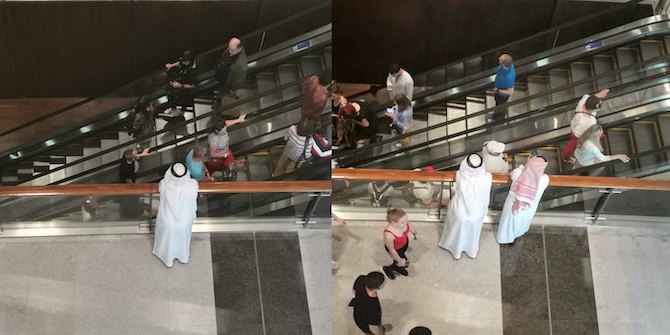by Ningning Xie

Stockholm’s Urban Context
Stockholm region has relatively low urban density (23.5/ha) -less than half of typical European cities (47.9/ha), and slightly lower than large Canadian ones (25.8/ha). It is also below the density threshold (35/ha) that enables lower car dependence. Yet, Stockholm has a higher percentage of total daily trips by motorised modes of public transport (31.6%), compared to its European (22.4%) and Canadian (13.1%) counterparts. The numbers are 22.1%, 34.5%, 11.6% for non-motorised modes, and 46.3%, 43.1%, 75.4% for motorised private ones. Stockholm also leads in many indicators pertaining to public transport use, compared to other global cities, including metro network length per 1000 persons, and metro boardings per capita.
One could argue Stockholm shares European travel culture where public transport is more accepted by all walks of life. However, the city has achieved relatively low car use, which is atypical for its density level. A more reasonable explanation might be its urban form. Stockholm stood out since the 1950s with its ground-breaking satellite town concept. Through robust urban rail networks, the city spread high-density, mixed-use, transit-oriented developments (TOD) along metro stations, with attractive conditions for pedestrians and cyclists. Such TOD nodes are embedded in low-density areas, from which feeder buses take residents to metro stations.
Applying a Life Course Perspective to Young Adults’ Mobility
In 2019, I studied as an exchange student in Stockholm for six months. Living in Bredäng, a suburban neighbourhood along the metro line in southwest Stockholm, I gained an immersive experience of the city’s unique urban context. I was impressed by its integration of urbanity and nature through well-connected, efficient transit systems, together with its travel culture and infrastructures that support active mobility. It struck a chord with many of my friends and I, who all come from diverse social and cultural backgrounds. As an urban researcher, I therefore decided to empirically understand the reasons behind such shared ‘shocks’ among us.
A life course perspective to mobility was used to explain our reactions. Based on psychological theories including the Theory of Planned Behaviour and the Habit Discontinuity Hypothesis, the approach tracks changes of travel behaviour during one’s life course. It assumes that travel behaviour is habitual over time, until key life events disrupt habits, and trigger deliberation on new travel decisions. The deliberation process could be moderated by personal factors including travel histories, attitudes, demands, and resources, and by external conditions, such as peers, travel culture, as well as built and natural environments. For us, studying abroad in Stockholm was a key life event.
Through retrospective, semi-structured interviews, a select group of seventeen foreign students from eleven countries (aged 21–28) who studied in Stockholm for six to twelve months, shared their travel experiences and attitudes towards the use of different transport modes in Stockholm, while comparing these experiences with their previous life courses and mobility patterns.
The Effects of Studying in Stockholm on Travel Behaviour and Attitudes
‘I didn’t have access to my car. But I didn’t really miss it.’
– Exchange student from Greece
Seventeen young adults were grouped into four life course typologies, based on their previous living contexts. The largest group is from car-oriented societies with little transit use, like small European towns. This group is characterised by dominant car use and rare transit use until they pursued higher education, when they moved to bigger cities. A second group, from car-oriented societies with access to transit, are originally from bigger cities, such as Athens. This group typically started transit use during secondary school, when they increasingly needed to travel independent of parents. Both groups considered cars more convenient and comfortable, contrasted by negative or sceptic attitudes towards transit systems or bicycles. A third group is from motorbike-oriented societies, such as smaller Indian cities, where cars reflect higher social status, while the use of public transit carries social stigma. Finally, the last group comes from more transit-oriented societies, like Tokyo, characterised by regular transit use as early as primary school, and the common perception that using public transit is a norm.
Despite various life courses, the life event of moving abroad to Stockholm made these young adults’ travel behaviour converge in this city. All seventeen young adults purchased transit period tickets as they arrived in Stockholm. Nevertheless, six of them also started cycling in the beginning or midway. All related this life event to their transit use or cycling behaviour.
A mechanism of travel behaviour change triggered by the life event could be revealed. By moving abroad to Stockholm, these young adults had to rethink their travel decisions, considering changed mobility resources, travel demands, and external conditions, incorporating travel attitudes and personal histories. For many, due to distance between destinations, the transit system in Stockholm was the only, albeit satisfactory, option. For some others, previous experiences and skills in cycling, and bicycle-friendly environments in Stockholm, also encouraged them to bike. A few even kept the cycling habits they formed in Stockholm, when they moved elsewhere.
Contrarily, these young adults’ travel attitudes, in response to the life event of studying in Stockholm, have varied by their life course typologies. Young adults from car-oriented societies, who previously held negative attitudes towards transit and bicycles, were more inclined to develop new, positive attitudes towards the two modes of transportation. Most have related their improved attitudes towards transit to its punctuality and efficiency, accessibility and connectedness, and comfort level. Many, including non-cyclists, also related their improved attitudes towards bicycles to the cycle-friendly culture and infrastructure in Stockholm. In contrast, attitudes of those from transit-oriented societies, or who experienced stronger cycling cultures, or who have strong preferences for cars, were less affected.
Another mechanism then emerged for travel attitudes evolution. Some young adults, by gaining pleasant travel experiences in transit and cycling in Stockholm, and comparing such experiences with negative ones before, generated new, positive attitudes towards these two modes. These positive attitudes were cumulatively integrated into their evaluation of different travel modes, which helps shape future travel decisions, when they move elsewhere, and particularly transit and cycle-friendly environments.
This piece is part of a series on urban development and the role of road infrastructure in forging socio-spatial conditions, based on contributions from participants in a closed LSE Roundtable in September 2021. Read the introduction here, and see other pieces below.
In this series:
- (Re)thinking Streets in Low Urban Densities by Alexandra Gomes, Apostolos Kyriazis, Clémence Montagne & Peter Schwinger
- The Future Development of the City of Kuwait: Kuwait’s Urban Form as a Case Study by Roberto Fabbri
- Pedestrian Dynamism Index: An Approach to Increasing Permeability between the Peripheral and Central City of Guadalajara by Monica Castañeda, Ricardo Fernandez and Roberto Robles-Arana
- Studying Abroad in Stockholm: Incentivising Young Adults Towards Greener Mobility by Ningning Xie
- Plan with a Purpose: A Systems Approach in Transportation Development and Liveable Cities by Lizao Chen
- Metropolisation and Spatial Segregation in Gulf Cities: The Cases of Abu Dhabi and Dubai by Moiz Uddin
- Rethinking Streets in North Obhur, Jeddah, Kingdom of Saudi Arabia by Alok Tiwari
- Safe and Active Mobility: A Prototype for the Re-Pedestrianisation of Residential Neighbourhoods in Oman by Gustavo de Siqueira
- Urbanisation and Physical Activity: Addressing the Needs of Omani Women by Ruth Mabry and Huda Al Siyabi






